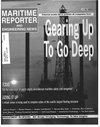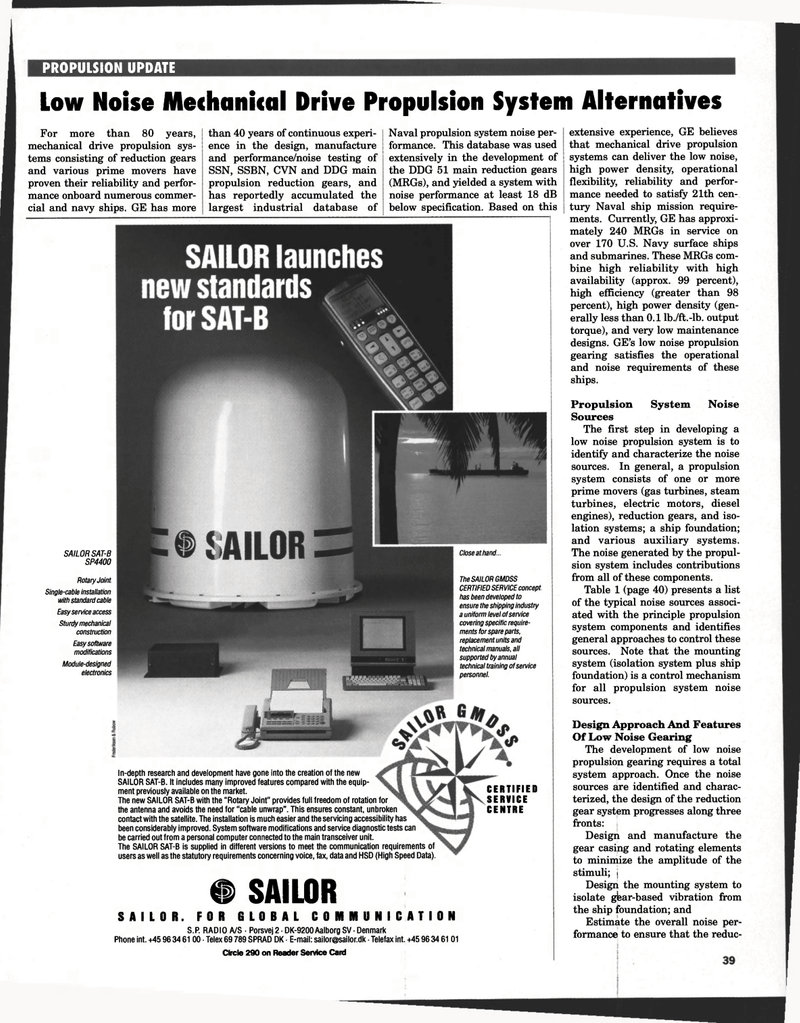
Page 47: of Maritime Reporter Magazine (April 1998)
Read this page in Pdf, Flash or Html5 edition of April 1998 Maritime Reporter Magazine
PROPULSION UPDATE
Low Noise Mechanical Drive Propulsion System Alternatives
For more than 80 years, mechanical drive propulsion sys- tems consisting of reduction gears and various prime movers have proven their reliability and perfor- mance onboard numerous commer- cial and navy ships. GE has more than 40 years of continuous experi- ence in the design, manufacture and performance/noise testing of
SSN, SSBN, CVN and DDG main propulsion reduction gears, and has reportedly accumulated the largest industrial database of
Naval propulsion system noise per- formance. This database was used extensively in the development of the DDG 51 main reduction gears (MRGs), and yielded a system with noise performance at least 18 dB below specification. Based on this extensive experience, GE believes that mechanical drive propulsion systems can deliver the low noise, high power density, operational flexibility, reliability and perfor- mance needed to satisfy 21th cen- tury Naval ship mission require- ments. Currently, GE has approxi- mately 240 MRGs in service on over 170 U.S. Navy surface ships and submarines. These MRGs com- bine high reliability with high availability (approx. 99 percent), high efficiency (greater than 98 percent), high power density (gen- erally less than 0.1 lb./ft.-lb. output torque), and very low maintenance designs. GE's low noise propulsion gearing satisfies the operational and noise requirements of these ships.
Propulsion System Noise
Sources
The first step in developing a low noise propulsion system is to identify and characterize the noise sources. In general, a propulsion system consists of one or more prime movers (gas turbines, steam turbines, electric motors, diesel engines), reduction gears, and iso- lation systems; a ship foundation; and various auxiliary systems.
The noise generated by the propul- sion system includes contributions from all of these components.
Table 1 (page 40) presents a list of the typical noise sources associ- ated with the principle propulsion system components and identifies general approaches to control these sources. Note that the mounting system (isolation system plus ship foundation) is a control mechanism for all propulsion system noise sources.
Design Approach And Features
Of Low Noise Gearing
The development of low noise propulsion gearing requires a total system approach. Once the noise sources are identified and charac- terized, the design of the reduction gear system progresses along three fronts:
Design and manufacture the gear casing and rotating elements to minimize the amplitude of the stimuli; j
Design the mounting system to isolate gfear-based vibration from the ship foundation; and
Estimate the overall noise per- formance to ensure that the reduc- m SAILOR
SAILOR. FOR GLOBAL COMMUNICATION
S.P. RADIO A/S • Porsvej 2 • DK-9200 Aalborg SV • Denmark
Phone int. +45 96 34 61 00 • Telex 69 789 SPRAD DK • E-mail: [email protected] • Telefax int. +45 96 34 61 01
Circle 290 on Reader Service Card
SAILOR SAT-B
SP4400
Rotary Joint
Single-cable installation with standard cable
Easy service access
Sturdy mechanical construction
Easy software modifications
Module-designed electronics
Close at hand...
The SAILOR GMDSS
CERTIFIED SERVICE concept has been developed to ensure the shipping industry a uniform level of service covering specific require- ments for spare parts, replacement units and technical manuals, all supported by annual technical training of service personnel.
CERTIFIED
SERVICE
CENTRE
In-depth research and development have gone into the creation of the new
SAILOR SAT-B. It includes many improved features compared with the equip- ment previously available on the market.
The new SAILOR SAT-B with the "Rotary Joint" provides full freedom of rotation for the antenna and avoids the need for "cable unwrap". This ensures constant, unbroken contact with the satellite. The installation is much easier and the servicing accessibility has been considerably improved. System software modifications and service diagnostic tests can be carried out from a personal computer connected to the main transceiver unit.
The SAILOR SAT-B is supplied in different versions to meet the communication requirements of users as well as the statutory requirements concerning voice, fax, data and HSD (High Speed Data).

 46
46

 48
48
